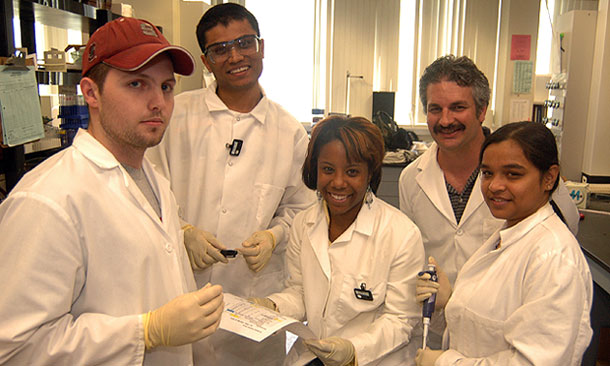Chemistry Professor Creates Super
Plants for a Changing Environment The complex carbohydrates in potatoes, wheat, rice and corn are more than just food to Christopher R. Meyer, professor of chemistry and biochemistry. They are the building blocks for renewable, biodegradable carbon resources — such as a substitute for petroleum — as well as a means of obtaining a safer and cleaner environment. Meyer recently received $318,505 as the first two-year funding of a five-year National Science Foundation grant in support of his research into a bacterial enzyme, ADP-glucose pyrophsophorylases. The enzyme plays a primary role in starch and glycogen synthesis in plants and bacteria. Meyer's research involves stimulating plants to produce more starch and glycogen. The extra starch can be used to make a variety of products. "One use for excess starch is as a 'starting material,' which through the process of fermentation, can be converted into ethanol," Meyer said. "The combustion engine, with little modification, can run on 85 percent ethanol. "Pellets made from starch are replacing Styrofoam packing material," the researcher explained. Styrofoam, which is made from petroleum, "ends up in landfills, where it stays for hundreds of years. Starch pellets dissolve in water." Cosmetic companies use starch in their products, Meyer noted, adding that it is used in paper recycling, detergents and as a substitute for plastic. Increased starch in plants is associated with increased photosynthesis and biomass. Plants with increased starch synthesis can help combat the greenhouse effect (warming that results from having too much carbon dioxide in the atmosphere). "Scientists used to think all that needed to be done to reduce the greenhouse effect was to plant more trees," said Meyer. "They soon discovered that approach didn't work, because the amount of carbon dioxide taken in by the plant and the amount of oxygen it releases quickly reaches an equilibrium. "One way to control the greenhouse effect is to stimulate starch synthesis, thereby creating a 'sink' for the carbon. The more carbon that is utilized in starch production, the less is released into the atmosphere," he explained. "The unique thing that our lab has been able to do," Meyer added, "is we have cloned and developed new gene combinations to yield diverse forms of the enzyme and have engineered genetically altered forms." Meyer's research team, working in collaboration with UC Irvine, deciphered the structure of a bacterial form of the enzyme and was able to depict it in three-dimensions. "Three-D structure is something all enzymologists and scientists who study proteins want to know," Meyer pointed out. "When you clone a gene, you know the sequence of the structure, but you don't know what it looks like or how it works on the molecular level. With the 3-D structure in hand, you can test many hypotheses using tools from genetics and bioinformatics to gain a deeper understanding of structure and function relationships."
|


 Produced by the Office of Public Affairs at California State University, Fullerton.
Contact the
Produced by the Office of Public Affairs at California State University, Fullerton.
Contact the